Some links on this page are affiliate links. They may generate revenue for this site but there’s no extra cost to you if you make a purchase. More on affiliate links
Guide to the Tower of London and Crown Jewels including tours and tickets
The Tower of London should be on the bucket list for any visit to London. The castle is an important part of British history and goes back to the Norman conquest in the 11th century. Today, this major city landmark is a UNESCO World Heritage Site. Not to mention a leading London attraction.
The castle was initially a fortress and royal residence. It was also an armoury, royal mint and even a menagerie to keep exotic animals like lions and polar bears. Since the 14th century, it’s the home of the famous Crown Jewels. But the most remembered of all is the history of imprisonments, gory tortures, murders and executions!
This famous city landmark has loads of history to tell. It’s an attraction not to be missed. So if visiting the Tower of London is on your bucket list, here’s the guide. It’ll give you insights including what to see, opening hours, buying tickets and practical tips. Sure tickets aren’t cheap but this hasn’t stopped visitors from coming.
YOU MAY ALSO LIKE
- Visitor’s Guide to Buckingham Palace
- Top Attractions in Central London
- Explore Cool Neighbourhoods in London
- MORE ON LONDON
Short History of the Castle

The Tower of London goes back to William the Conqueror, England’s first Norman king after he defeated the Anglo-Saxon army under King Harold in 1066. To assert his rule on the conquered population, he built hundreds of fortresses from the south coast to the north of England. Among them was the Tower of London.
Initially built from timber, William later ordered a stone castle to replace the timber fortress. Completed in 1087, the castle was the tallest building in London at the time and was then known as the White Tower. Through the centuries, there were modifications and expansions to the Tower of London that you see today.
The castle was not only a fortress but also a royal residence. Over the centuries, it had other uses. In the 13th century, King John and later King Henry III kept wild animals here. For several centuries, the castle was a mint and repository of official records. During the Tudor period (1485-1603), it was also an armoury and prison.
It was at this castle that King Henry VIII imprisoned his wives (Anne Boleyn and Katherine Howard) and then ordered their executions. After the Tudor period, the Tower of London was less used as a royal residence. It went into a period of decline, was almost neglected and was left in a very poor state.
Over the centuries, there have been many reports of ghosts sighted at the Tower of London. After all, the castle was the site of many tortures, murders and executions. Among them is the ghost of Anne Boleyn haunting the Chapel Royal. Other notable ghosts include King Henry VI, Sir Walter Raleigh, Lady Jane Grey and Guy Fawkes.
The castle gained popularity as a tourist attraction in the mid-19th century. It was so popular that a ticket office opened in 1851. Curious Londoners were drawn to the castle’s medieval past and grim reputation. Another reason was to see the famed Crown Jewels. Today, they are still reasons to visit the Tower of London.
Tips for Visiting the Tower of London

Visiting this medieval castle is an unforgettable experience. It’s on the top of the list of things to do for many first time visitors to the city. After all, the castle has been part of the London landscape for 10 centuries and a large area to cover on foot. To make the best of your visit, here are some insider tips.
Buying Tickets Online
Tickets to the Tower of London are not cheap. That said, you can buy tickets from the booths near the castle or online from several travel sites. Book online for cheaper tickets. Not only that, you avoid waiting in the queue at the ticket booth. There’s more information about tickets in several sections below.
Best Days to Visit
The summer months and English school holidays are often busy days. Weekends and public holidays (including bank holidays) get even busier. So you can expect huge crowds and long queues during these times. For a smaller crowd and shorter waits, weekdays are the best days to come especially mid-week.
Best Time to Arrive
The best time to come is right away at opening time before the crowd arrives. It starts to build up 30 minutes after opening and reaches its peak by noon. So arrive early for a smaller crowd. If you can’t, consider arriving 2-3 hours before closing. The crowd usually starts to dwindle after 2 PM.
How Long to Visit
Most visitors stay around 3 hours to tour the Tower of London but not unusual for some to stay up to 5 hours. The queue to see the Crown Jewels can last up to 60 minutes. So factor in the extra time for the queue if you plan to see these famous treasures. Read below how you can save yourself from the long queue.
See the Crown Jewels First
The Crown Jewels are the highlight of all the attractions. The queue to see these treasures starts to build 30 minutes after opening. And an hour after opening, you could be waiting up to 60 minutes just to get inside. If the Crown Jewels is on your must-see list, then come early at opening time and make it your first stop.
Next, Visit the White Tower
The White Tower is the main and oldest part of the castle. It’s another star attraction though never as crowded to see the Crown Jewels. So make it your next stop after the Crown Jewels. There are 4 floors to explore. And there’s plenty to see including ancient weapons, armour, a royal chapel and an execution block.
Take the Yeoman Warder Tour
Join a Yeoman Warder on a free guided tour of the castle grounds. The one-hour tour is optional but recommended. It’s very informative if you want to know more than just sightseeing the sights. After you’ve seen the Crown Jewels, visited the White Tower and left with an hour to spare, then the tour should be on your bucket list.
Wear Good Walking Shoes
The Tower of London is 10 centuries old castle and covers 5 ha (12 acres). Some areas of the castle grounds are uneven cobblestones and there’s plenty of walking to do. In addition, walking up a flight of stairs in many of the towers – no lifts (elevators). So wear comfortable walking shoes for the visit.
Meet the Famous Yeoman Warders
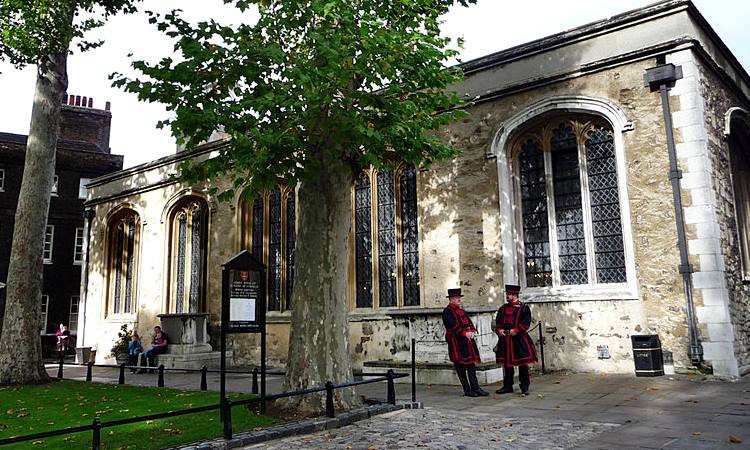
It’s hard to miss the sight of the Yeoman Warders (nicknamed Beefeaters) in their distinct dark blue Tudor-style uniforms. They have been guarding the castle since the 15th century. Today, the Warders not only provide security but also perform ceremonial duties, conduct tours and oblige enthralled tourists for selfies!
The Warders are retired personnel from the military with at least 22 years of service. To qualify, they must have served with distinction, retired with the rank of warrant officer and been awarded the Long Service and Good Conduct Medal. The Yeoman Warders don’t commute to work but actually live with their families at the castle.
The Warders really know the ins and outs of the castle. After all, they live here and so know the place better than anyone else. So they are the first people to ask if you need directions. They are also the ones taking visitors on a tour. And if you want to know more, don’t hesitate to ask a Yeoman Warder.
What to See at the Tower of London
While you’re free to roam on your own, some buildings and areas are off-limits to visitors. These include the Queen’s House where the Resident Governor resides. Mint Street where many of the Yeoman Warders and their families live is also off-limits. Having said that, don’t forget to pick up a free guide map when you visit.
Guards at the Tower of London

You’ll come across the Tower Guards on sentry duty outside the Queen’s House and Waterloo Barracks, where the Crown Jewels are kept in the Jewel House. It’s hard to miss them wearing their striking red tunics and bearskin hats. When the Guards are marching, remember to stay clear of their tracks.
The Guards work together with the Yeoman Warders to protect the castle. While the Yeoman Warders have retired from the military, the Guards are serving military personnel. They are fully trained soldiers from active regiments in the British Army. And a unit at the Tower of London includes an officer, 6 NCOs and 15 soldiers.
Unlike the Yeoman Warders, the Guards are not here to talk to or assist visitors. Sure, you can take photos but don’t obstruct the Guards from performing their duties. The Guards on the sentry change every 2 hours. So don’t miss the chance to watch the “new” Guards replace the “old” Guards in the famous British military tradition.
The Crown Jewels

The Crown Jewels are kept in the Jewel House at the Waterloo Barracks. These priceless treasures are the regalia of the British monarchy and are kept in shatterproof glasses. For many visitors, seeing the treasures first-hand is the highlight of the visit. So come early and be here at opening time before the long queue builds up.
The Crown Jewels are a unique collection and powerful symbols of the British monarchy. Many are ceremonial objects that have been used for the coronation of kings and queens since the 14th century. Treasures include crowns, rings, orbs, sceptres and ceremonial maces. Others include gold and silver plates, swords and robes.
Highlights include the 17th-century St. Edward’s Crown worn by the new king or queen for their coronation. The Imperial State Crown is worn after the coronation and adorned with nearly 3,000 precious stones including diamonds and pearls. The Sovereign’s Orb is made of gold, diamonds and other precious stones.
The White Tower

Built in the 11th century, the 4-floor White Tower is the oldest and most important part of the castle. It was not only a military fortress but also a royal residence. The castle was a reminder of Norman power over the conquered Anglo-Saxons. Through the centuries, the tower was also a prison and for storing gunpowder.
The White Tower is the next main attraction after the Crown Jewels. The highlight is the Royal Armouries on the lower 2 floors. It’s a unique collection of historic weapons and armour once used by kings, noblemen and common soldiers. Exhibits include bows, arrows, swords, chest armour, mortars, cannons and muskets.
Then walk up a flight of stairs to see the Chapel of St. John the Evangelist. It’s a simple but well-preserved Norman church. On the top floor is an executioner’s block from the 18th century but the axe is from the Tudor period. The basement is believed to be the site of ghastly interrogations and tortures of prisoners including Guy Fawkes.
Guided Tour With the Yeoman Warders
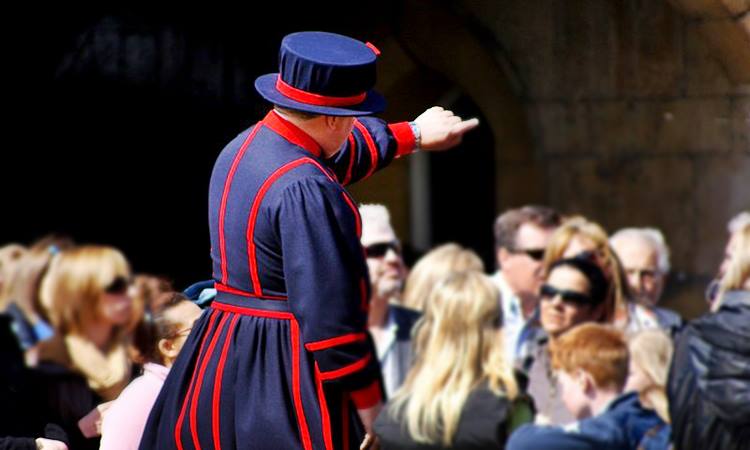
Follow a Yeoman Warder on a guided tour of the Tower of London. The tour lasts an hour and won’t cost you an extra penny – it’s part of the ticket price and no booking is required. Meet up with a Warder near the entrance waiting to begin the tour. It starts every 30 minutes with the first at 10:00 AM and the last at 3:30 PM.
Following a Yeoman Warder on a tour is optional but highly recommended. It’s very informative and the Warders are certainly entertaining. During the tour, you’ll hear stories about the castle’s long history. You’ll get about famous people imprisoned here and the gory tortures and executions that took place.
The tour doesn’t take you inside any building but outdoors around the castle grounds. The walk passes uneven cobbled walkways and some flight of steps. So wear comfortable walking shoes. Tours are in English and may cancel due to unsuitable weather such as rain and to accommodate large crowds.
The Fusilier Museum

The history of the Royal Regiment of Fusiliers began in 1685. King James III initially formed the regiment to protect the cannons at the castle. And through the centuries has served from the American War of Independence to the Afghanistan campaign. Today, the Tower of London is still the regiment’s headquarters.
You’ll find the Fusilier Museum on the ground floor of the regiment’s headquarters. It’s housed in what was once the officers’ quarters. Not a big place but interesting for a peak about the history of the regiment. The museum takes you through 300 years of history from its early years to the present.
There’s a rich collection of uniforms, photographs, flags, insignias and medals. Among the medals are 12 of the 20 prestigious Victoria Crosses awarded to soldiers of the Royal Fusiliers. There are also personal letters and diaries written by soldiers. Not to mention various war souvenirs taken from the defeated enemies.
The Bloody Tower
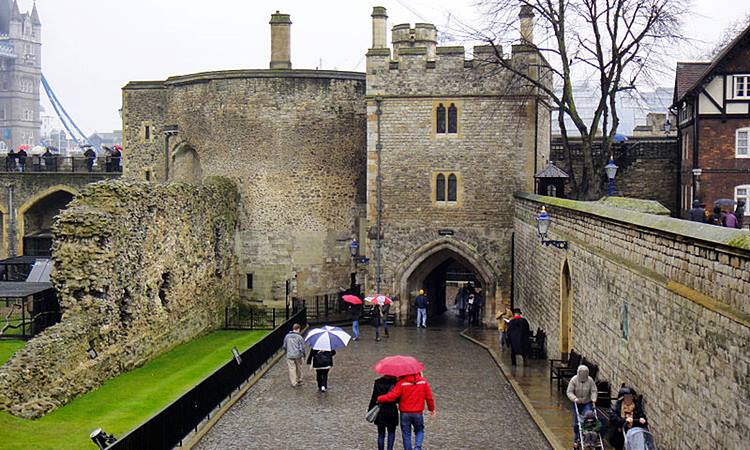
The Bloody Tower has an infamous past! It was here Richard III confined his two young nephews, Edward V and Richard of Shrewsbury in 1483. The two princes mysteriously disappeared. Believed to be murdered by Richard III, who became the new king. In 1674, workers discovered bones thought to be of the two young boys.
Sir Walter Raleigh was a famous prisoner here from 1603 to 1617. Being a prisoner of high rank, his stay was in fact comfortable compared to other prisoners. He had partitioned rooms and lived with his family. After his release, he led a failed mission to the Americas. Upon his return, he was beheaded in 1618 though not at the castle.
Visit the Bloody Tower and learn about the two young princes who stayed and disappeared in the tower. You can also visit a recreation of Sir Walter Raleigh’s prison on the ground floor – not a dingy dungeon but a pleasant prison for its time. After all, Sir Walter Raleigh was a prisoner of high status.
Wakefield Tower
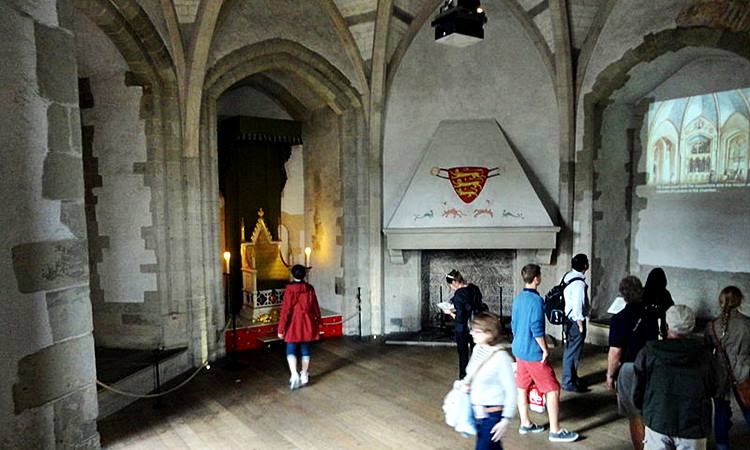
Wakefield Tower (originally Blundeville Tower) was the royal residence of King Henry III who ruled during the 13th century. The tower was initially near the edge of the River Thames. Henry III would arrive by boat and use the private stairs to his lodging. The place was not used by other kings after the death of Henry III in 1272.
Wakefield Tower is made up of 2 floors. It’s the second largest tower in the castle and the stone walls are much thicker than the other towers. The royal lodging was luxurious for the period. The main room was probably the audience chamber. And there’s a replica of a throne and other pieces of medieval furniture.
There’s a private chapel used by the kings. The chapel was once the murder scene of the deposed King Henry VI in 1471. On the orders of Edward IV, Henry VI was imprisoned here and later stabbed while praying. Edward IV would later become the new king. A marble tablet marks the spot where the murder took place.
Beauchamp Tower
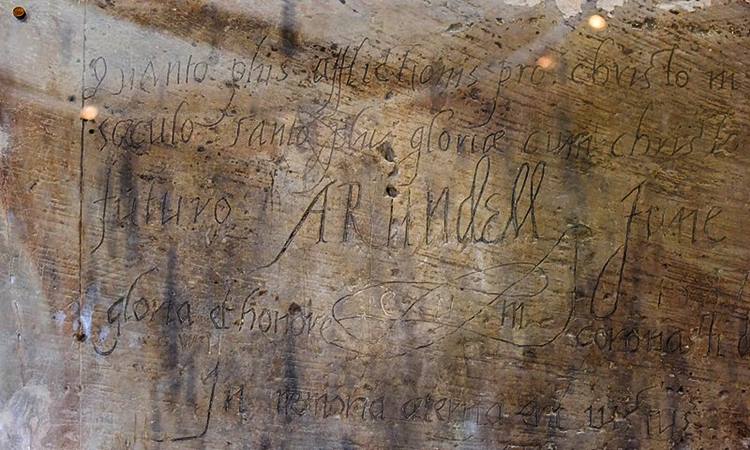
Beauchamp Tower (pronounced “beecham”) takes its name after Thomas Beauchamp. He was imprisoned here in 1397 on the orders of King Edward I for rebellion. The tower has a long history of keeping prisoners of high status. It was not only a prison but also another gruesome place in the castle for interrogation and torture.
Among the notable prisoners was Lady Jane Rochford. She was tortured to confess against Catherine Howard (wife of King Henry VIII) and then beheaded in 1542. Catherine Howard was also beheaded on the same day. Other notables were Robert Dudley (Earl of Leicester), Philip Howard (Earl of Arundel) and Lord Guilford Dudley.
Beauchamp Tower is built mostly of brick but externally from stone. The prison is most famous for its graffiti carved onto the walls by the prisoners – probably to pass their time and be remembered after their death. The carvings are still visible, giving you a connection to the prisoners who were once held here.
Chapel Royal of St. Peter ad Vincula
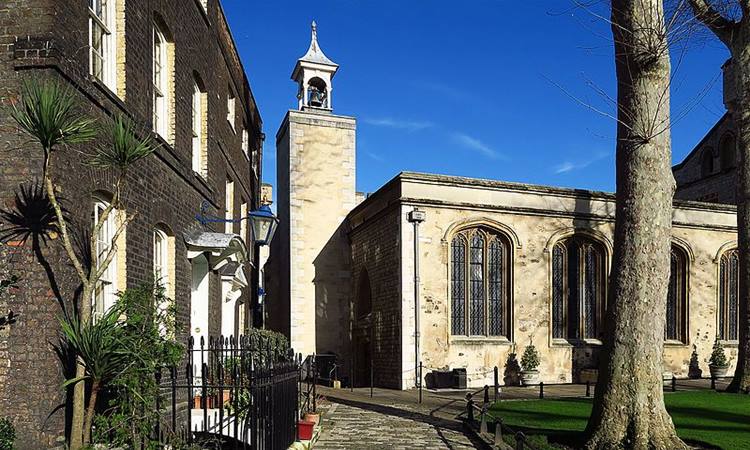
Chapel Royal of St. Peter ad Vincula (St. Peter in Chains) is under the jurisdiction of the monarch rather than a diocese. The original chapel goes back to the 11th century but the current is from 1520, built during the reign of King Henry VIII. Visitors are welcome but close on Sundays and other religious holidays days for services.
Inside the chapel are crypts of prominent prisoners executed at the Tower of London. Two of King Henry VIII’s wives, Anne Boleyn and Catherine Howard are buried here. It’s also the final resting place of Lady Jane Grey (Queen of England for just 9 days in 1553) and her husband Lord Guildford Dudley.
The chapel has undergone several renovations since the 17th century. The vaulted ceiling gives the chapel a grand lofty flair. The interior is richly decorated and contains many splendid memorials. 17th-century additions include a beautiful organ with carvings by the Anglo-Dutch sculptor Grinling Gibbons.
Memorial at Tower Green
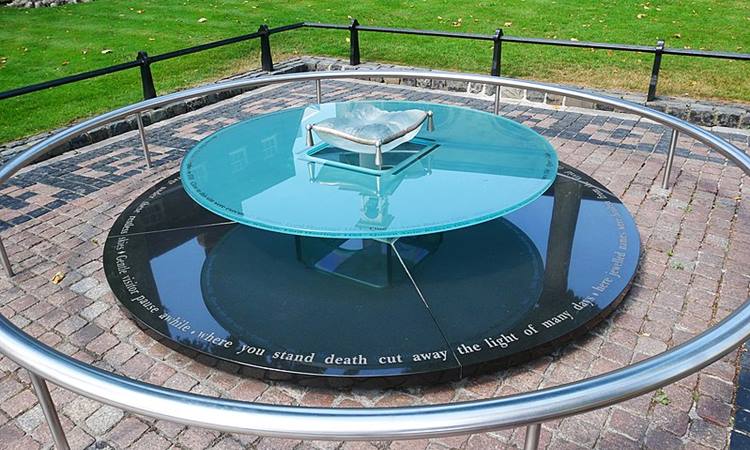
Tower Green is a green open space south of the Chapel Royal. The spot is thought to be the site of several beheadings. There are opposing views though about the exact location. Though we may never know, Tower Green has a small memorial in memory of those imprisoned at the Tower of London and later executed.
Executions at the Tower Green were a private event reserved only for prisoners of high rank such as royalty and nobility. This was to keep the condemned away from the indignity of a jeering crowd. And also to spare the monarchs from bad publicity. Less notable prisoners on the other hand were executed outside the castle.
Prisoners of high rank executed at the castle included Anne Boleyn and Catherine Howard, who were the queens of England. Among the nobilities were William Hastings (Baron d’Hasting), Jane Boleyn (Viscountess Rochford) and Robert Devereux (Earl of Essex). Other notable figures were Lady Jane Grey and the Countess of Salisbury.
The Famous Black Ravens
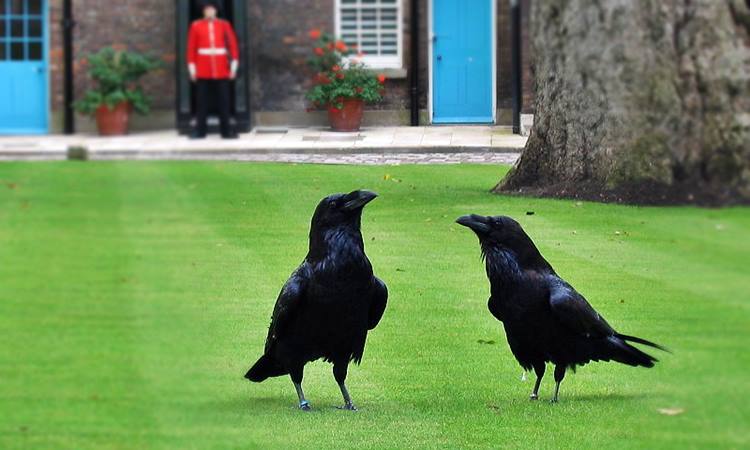
Get a chance to see the famous black ravens. They are not just any birds but “royal guests”. A superstition that goes back to the 17th century says if the ravens were to fly away, the monarchy and the country would fall. So generations of ravens have been living here as guests. But a tradition rather than superstition.
There will always be at least 6 ravens. The birds are under the special care of a Yeoman Warder called the Ravenmaster who treats them like royalty. They roam the castle during the day and return to the aviary (near Wakefield Tower) on their own at night. They can’t fly far since their flight feathers on one wing have been clipped.
The ravens respond only to the Ravenmaster. Don’t try to feed them or get too close, the ravens easily bite if they feel threatened. The birds are well-fed and live on a diet of raw meat such as liver, beef trimmings and rabbit parts as well as bird biscuits soaked in blood. And once a week, they get a thorough check-over.
Visitor Amenities & Facilities

For security reasons, you can’t bring in large bags and there are no luggage storage facilities or lockers here. A guide map of the castle is available on site. And if you need to use the internet, free and unlimited Wi-Fi access is available. Here is some practical information about other facilities for visitors.
Cafés & Food Kiosks
There are a couple of food options if you’re hungry. The New Armouries Café serves fish and chips, sandwiches, soup, salads, pastries, and hot and cold drinks. The outdoor Raven Café offers tasty takeaway snacks. The Jewel Kiosk (near the Jewel House) and Wharf Kiosks (near the riverside) offer sandwiches, cakes, and hot and cold drinks.
Gift & Souvenir Shops
There are also a few shops. The Tower of London Shop sells souvenirs, jewellery, gifts, toys and books. The White Tower Shop offers unique gifts and souvenirs inspired by exhibits at the White Tower. Visit the Crown Jewels Pop-Up Shop and Jewel House Shop for more gifts, souvenirs and merchandise.
Toilets
You’ll find male, female and accessible toilets at the Brick Tower – behind the Jewel House. There are male-only toilets at the Salt Tower. And female-only and accessible toilets at the Cradle Tower. There’s also a toilet near the New Armouries Café. You’d have to borrow a special RADAR key from the café staff and return it after use.
Travelling with Young Kids
Travelling with kids is a must for any family trip. And if you’re travelling with a baby or toddler, you’ll find baby changing facilities at the ladies-only toilets and accessible toilets at the Brick Tower. Visitors are advised to instruct their children to seek help from a Yeoman Warder if they get lost or need first aid.
Pushchairs & Prams
The castle is centuries old and some areas are not pushchair friendly because of the cobbled grounds. Besides, pushchairs are not allowed in the White Tower and there are no lifts (elevators) in any of the towers. If you need to park a pushchair, there’s a buggy park at the White Tower entrance and Middle Drawbridge.
Tower of London Visiting Hours
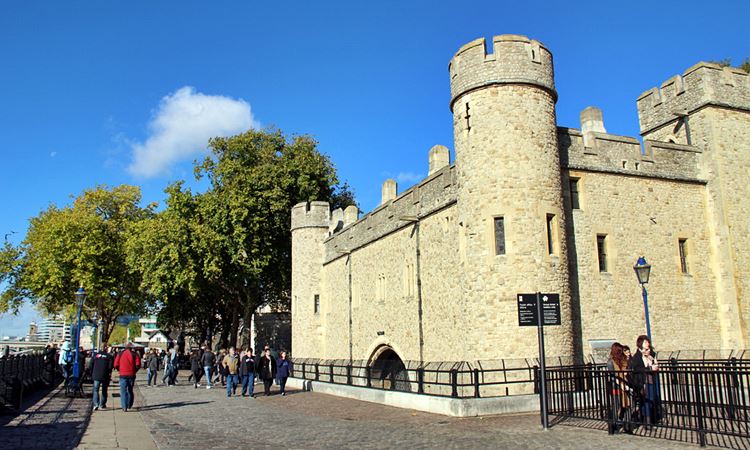
The Tower of London opens daily to visitors except 24-26 December and 1 January. The last admission is 60 minutes before closing but you wouldn’t see much. It’ll take you at least 90 minutes for a quick tour of the castle. For most visitors, it’s around 3 hours to treasure the visit to this historical site.
The following are the general opening hours. Visiting hours may change for various reasons. So, visit the Tower of London website for updates.
1st March – 30th October:
- Sundays and Mondays: 10:00 AM – 5:30 PM
- Tuesday to Saturday: 9:00 AM – 5:30 PM
- Last Yeoman Warder tour: 3:30 PM
- Last admission: 4:30 PM
31st October – 28th February:
- Sundays and Mondays: 10:00 AM – 4:30 PM
- Tuesday to Saturday: 9:00 AM – 4:30 PM
- Last Yeoman Warder tour: 2:30 PM
- Last admission: 3:30 PM
Tower of London Tickets

You can buy tickets from the booths near the Tower of London or online from several booking sites. Book online and you usually pay 10 percent less than the booth prices. What’s more, you don’t have to stand in line at the booths, which can get quite long during busy times. You go straight to the entrance with an online ticket.
Tickets From Historic Royal Palaces
You can buy entry tickets online from Historic Royal Palaces, the charity body tasked with looking after the castle. Here are the ticket prices including taxes and fees as of 1 March 2022. The entry includes all the attractions and a guided tour with the Yeoman Warders. Note, tickets bought from the official site are non-refundable.
- Adult (18-64 years) – £29.90
- Senior citizen (65+ years) – £24.00
- Full-time student – £24.00
- Disabled – £24.00
- Child (16-17 years) – £24.00
- Child (5-15 years) – £14.90
- Child (less than 5 years) – free
If you’ve kids aged 5-15 years travelling with you, consider the Family Saver for additional savings. You start to save when at least 2 kids travel with you and save even more with 3. Having said that, it’s cheaper to buy individual tickets if only 1 child is travelling with you.
- Family Saver 1 – 1 adult and up to 3 children (5-15 years) – £52.20
- Family Saver 2 – 2 adults and up to 3 children (5-15 years) – £82.10
Tickets From Online Travel Agencies (OTA)
You may want to check out Get Your Guide for entry tickets. Tickets are from the Historic Royal Palaces and prices are the same. But Get Your Guide gives you the option to book now and pay later, 72 hours before the visit. Besides, there’s a full refund if you decide to cancel 24 hours before the visit.
There are also special tours at Get Your Guide. These include early access tours before the castle opens to the public. A big plus is you get to see the Crown Jewels before the crowd arrives. You may want to check out Viator and Tiqets for tickets and special guided tours as well. Offers vary, so shop around.
Purchase a Sightseeing Pass
You pay only once and there are big savings visiting multiple attractions with the London Pass and Explorer Pass. Both include the Tower of London and other top attractions like Westminster Abbey, St Paul’s Cathedral and London Zoo. You can also board the hop-on hop-off bus tours and boat cruises. Let’s take a look at the 2 passes.
- London Pass – You can choose a pass valid for 1, 2, 3, 4, 5, 6, 7 and 10 days to access more than 80 attractions. There’s no limit to how many you can visit during the validity period. There are plenty of savings here visiting many attractions.
- Explorer Pass – You can choose a pass for 2, 3, 4, 5, 6 and 7 attractions out of over 70. And it’s valid for 60 days after the first activation. With the pass, you have the flexibility to visit anytime you want within 60 days besides the big savings.
How to Get to the Castle
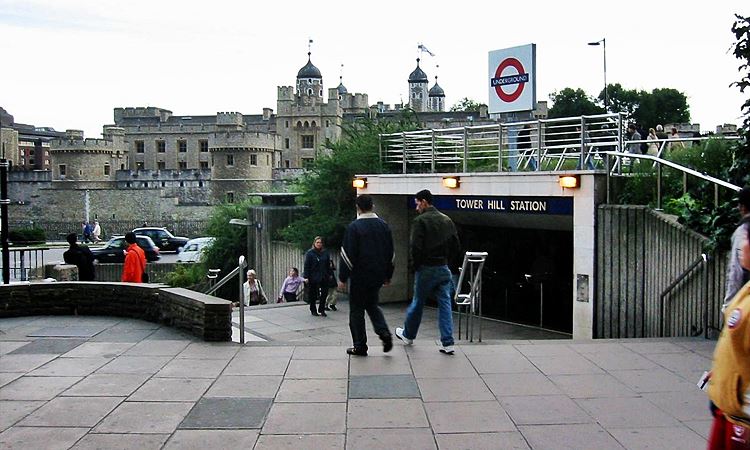
The Tower of London is on the eastern side of Central London. It’s less than 5 minutes walk from Tower Hill Underground Station (Circle and District Lines). Slightly further and 10-15 minutes walk away are Monument (Circle and District Lines), Aldgate (Circle and Metropolitan Lines) and Aldgate East (Hammersmith & City Line) Stations.
Buses travelling on routes 15, 42, 78, 100 and RV1 stop near the Tower of London as well as hop-on hop-off tour buses. If using the London Pass or Go City Explorer Pass, save your money and use the hop-on hop-off buses provided. Taxis are expensive but if there are 3-4 people in a cab, it’s an option to consider.
Hotels Near the Tower of London

London is well-connected by Underground trains that you don’t have to stay close to the Tower of London to visit. That said, many visitors overlook the location as a place to stay. But the area does offer value for your money for every budget. Besides, there’s more to see and do in the area than just visiting the Tower of London.
What’s in the area? First of all, the famous Tower Bridge across the River Thames is a short walk away. And the walkway along the river offers some great views of London. Other attractions include Leadenhall Market, the Monument, St Paul’s Cathedral, the Sky Garden, the Bank of England Museum and Old Spitalfields Market to name a few.
If you want to stay near the Tower of London, below are some suggestions. For more options, click this for hotels near the Tower of London. The ones mentioned below have been picked for their many favourable guest reviews and guest rating scores ranging from good to excellent.
- Ibis London City ⭐⭐⭐ – You’re not only within a 10-15 minutes walk from the Tower of London and St Paul’s Cathedral but also Shoreditch. It’s a stylish hotel with modern and colourful interiors. Family and triple rooms are also available.
- The Tower Hotel ⭐⭐⭐⭐ – Situated in a redeveloped dock area with scenic views of the River Thames and Tower Bridge. Facilities include concierge service, a gym, restaurants and a business centre. Rooms range from standard to suites.
- Novotel London Tower Bridge ⭐⭐⭐⭐ – You’re a short hop away from the historic castle. There’s a gym, sauna and a restaurant that serves from morning till night. Standard rooms and suites are spacious with contemporary furnishing.
- citizenM Tower of London ⭐⭐⭐⭐ – The hotel is so close that some guest rooms offer magnificent views of the Tower of London. All rooms have king-size beds, sound-proof windows and blackout blinds. Offers a very good buffet breakfast.
